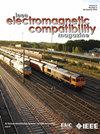An Energy-Selective Beamforming Approach for HPM Protection in Array Antennas
IF 2.5
3区 计算机科学
Q3 ENGINEERING, ELECTRICAL & ELECTRONIC
IEEE Transactions on Electromagnetic Compatibility
Pub Date : 2025-04-03
DOI:10.1109/TEMC.2025.3553220
引用次数: 0
Abstract
This article introduces an energy selective beamforming array (ESBA) that adaptively adjusts its array factor in the defense mode for safeguarding sensitive front-end circuits from high-power microwave threats. Novel energy selective phase shifters (ESPSs) are integrated with the ESBA to impart chaotic phases signals exceeding the threshold level, by which the ESBA enters a defocused state. Operational mechanism of the ESPS is explained through equivalent circuit and resonance theory, and a comprehensive design methodology is provided for ESBA. Notably, the defense level of the proposed ESBA scales with the array size, which shows a great advantage over other protection methods. Furthermore, the ESBA is compatible with other energy-selective protection methods and electronic beam-scanning technologies. To validate this concept, a microstrip-patch-based prototype is fabricated and measured. Theoretical, numerical, and experimental results demonstrate good agreements. The prototype operates in the frequency range of 2.3–2.4 GHz, providing a maximum protection level of approximately 52 dB in the defense mode. The insertion loss introduced by the ESPS is maintained within 1 dB. With its compact form factor and low manufacturing cost, the ESBA technology is suitable for passive and active phased arrays.一种用于阵列天线HPM保护的能量选择波束形成方法
本文介绍了一种能量选择波束形成阵列(ESBA),该阵列在防御模式下可自适应调整其阵列因子,以保护敏感前端电路免受高功率微波威胁。将新型能量选择移相器(ESPSs)集成到ESBA中,传递超过阈值的混沌相位信号,使ESBA进入散焦状态。通过等效电路和谐振理论解释了ESPS的工作机理,并给出了ESBA的综合设计方法。值得注意的是,所提出的ESBA的防御水平随阵列大小而变化,与其他保护方法相比具有很大的优势。此外,ESBA与其他能量选择保护方法和电子束扫描技术兼容。为了验证这一概念,制作并测量了基于微带贴片的原型。理论、数值和实验结果均证明了较好的一致性。该样机工作在2.3-2.4 GHz的频率范围内,在防御模式下提供约52 dB的最大保护等级。ESPS引入的插入损耗维持在1db以内。由于其紧凑的外形和低制造成本,ESBA技术适用于无源和有源相控阵。
本文章由计算机程序翻译,如有差异,请以英文原文为准。
求助全文
约1分钟内获得全文
求助全文
来源期刊
CiteScore
4.80
自引率
19.00%
发文量
235
审稿时长
2.3 months
期刊介绍:
IEEE Transactions on Electromagnetic Compatibility publishes original and significant contributions related to all disciplines of electromagnetic compatibility (EMC) and relevant methods to predict, assess and prevent electromagnetic interference (EMI) and increase device/product immunity. The scope of the publication includes, but is not limited to Electromagnetic Environments; Interference Control; EMC and EMI Modeling; High Power Electromagnetics; EMC Standards, Methods of EMC Measurements; Computational Electromagnetics and Signal and Power Integrity, as applied or directly related to Electromagnetic Compatibility problems; Transmission Lines; Electrostatic Discharge and Lightning Effects; EMC in Wireless and Optical Technologies; EMC in Printed Circuit Board and System Design.

 求助内容:
求助内容: 应助结果提醒方式:
应助结果提醒方式:


